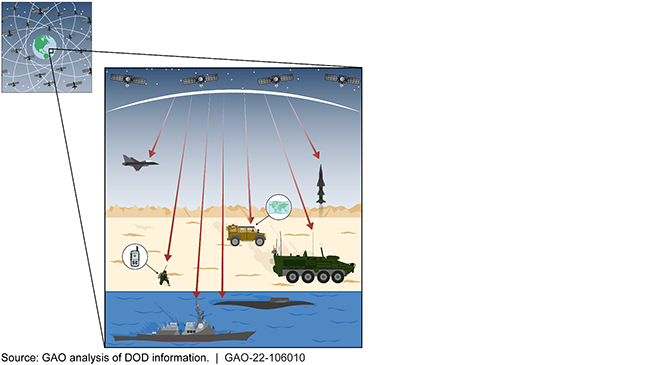GPS Alternatives: DOD is Developing Navigation Systems but is Not Measuring Overall Progress
Fast Facts
The military relies on its Global Positioning System for many operations, but threats like cyber threats and jamming are constant risks. To maintain GPS capabilities, DOD is modernizing the system and also developing alternatives.
But we found that 4 of 5 alternative systems in development didn't have complete business cases—which justify the project and evaluate associated benefits, costs, and risks. So DOD leaders didn't have enough information to support crucial decisions at the start. We also found that DOD's oversight council for GPS hasn't set goals for measuring progress on the alternatives.
We recommended that DOD address these issues.
The GPS system provides positioning, navigation, and timing data to the military

Highlights
What GAO Found
The U.S. military relies on its Global Positioning System (GPS) to provide position, navigation, and timing data crucial to its operations. Access to these data, collectively known as PNT, and GPS face multiple threats, including: (1) anti-satellite weapons, (2) jamming, (3) spoofing, and (4) cyber. Given GPS's vulnerabilities, the Department of Defense (DOD) is modernizing GPS by adding a stronger encrypted signal, known as M-code, and using technologies like anti-jam antennas. Even with upgrades, vulnerabilities will remain.
The military services are developing alternative PNT capabilities to complement GPS. Of the five PNT efforts that have started development, four efforts had incomplete business cases (see figure). Specifically, the Navy had incomplete business cases for its four alternative PNT efforts, as the Navy either did not have or was drafting business case elements. A complete business case gives decision makers information at the start of product development to set the program up for success and can limit cost, schedule, and technical problems.
Status of Business Case Documents for Alternative Position, Navigation, and Timing (PNT) Efforts in Development

In addition to the above efforts, DOD is at the advanced prototyping stage for several alternative PNT efforts, including improved clocks, and satellite systems.
DOD's overall PNT portfolio is managed by the PNT Oversight Council, a statutorily established senior-level body. However, the Council has largely prioritized modernizing the existing GPS system over alternative PNT efforts during recent meetings and has no strategic objectives or metrics to measure progress on the alternative efforts. Defined objectives and metrics would help the Council better measure overall performance and mitigate any potential gaps in PNT capabilities as the military transitions to using M-code.
Why GAO Did This Study
DOD primarily relies on GPS for accurate PNT data, which is essential to effective military operations. However, multiple threats can render GPS data unavailable or inaccurate. DOD recognizes the threats to GPS and is taking steps to address them by developing more robust GPS capabilities and alternative PNT technologies. GAO was asked to review DOD's acquisition of alternative PNT technologies.
This report discusses (1) the threats facing GPS; (2) DOD's alternative PNT efforts and their business cases; and (3) DOD's oversight of its PNT portfolio. This is a public version of a sensitive report that GAO issued in April 2022. Information that DOD deemed to be sensitive has been omitted.
GAO compiled and analyzed GPS threat information from relevant organizations and DOD officials; analyzed DOD documents; reviewed DOD PNT portfolio plans and strategies; interviewed DOD officials; and sent a questionnaire to DOD PNT program officials and analyzed results.
Recommendations
GAO recommends that the Secretary of the Navy ensure the Navy's alternative PNT efforts have complete business case elements, such as an acquisition strategy. GAO also recommends that the PNT Oversight Council establish strategic objectives and metrics to measure the progress of its PNT portfolio overall. DOD concurred with one recommendation and partially concurred with the other. GAO maintains both recommendations are valid.
Recommendations for Executive Action
| Agency Affected | Recommendation | Status |
|---|---|---|
| Department of the Navy | The Secretary of the Navy should ensure its PNT efforts have complete business cases, including that:
(Recommendation 1) |
Open – Partially Addressed
DOD partially concurred with this recommendation and agreed that business case elements, such as technology and schedule risk assessments, are an important part of a business case analysis, but stated acquisition officials have the flexibility to meet those elements through reasonable alternatives. We maintain that a complete business case including requirements documentation, an acquisition strategy, an independent cost estimate, a schedule risk assessment, and a technology risk assessment is the knowledge-based acquisition leading practice that has shown a statistically significant correlation with improved cost and schedule performance. Due to this, we maintain our recommendation is still valid. DOD provided additional program documentation that they believe shows DOD already met all elements of this recommendation. We evaluated the evidence provided by DOD and agree with DOD that the ACNS, CEC, and the AN/WSN-12 programs have completed our recommendation elements based upon the additional documentation. The GPNTS recommendation elements, however require further action, or evidence of action already taken, before we completely close out this recommendation as implemented.
|
| Department of Defense | The Secretary of Defense should ensure that the PNT Oversight Council creates strategic objectives and metrics to measure progress towards those objectives for DOD's alternative PNT efforts. (Recommendation 2) |
Open
DOD agreed with this recommendation and stated that the PNT Executive Management Board has developed objectives and metrics, which they plan on presenting at the PNT Oversight Council. Additionally, progress against the metrics and objectives will be addressed in the FY23 PNT Oversight Council's annual report to Congress.
|
